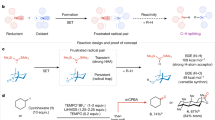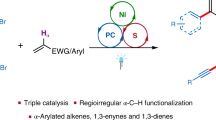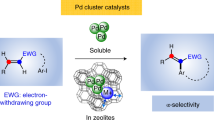Abstract
Frustrated Lewis pairs are compounds containing both Lewis acidic and Lewis basic moieties, where the formation of an adduct is prevented by steric hindrance. They are therefore highly reactive, and have been shown to be capable of heterolysis of molecular hydrogen, a property that has led to their use in hydrogenation reactions of polarized multiple bonds. Here, we describe a general approach to the hydrogenation of alkynes to cis-alkenes under mild conditions using the unique ansa-aminohydroborane as a catalyst. Our approach combines several reactions as the elementary steps of the catalytic cycle: hydroboration (substrate binding), heterolytic hydrogen splitting (typical frustrated-Lewis-pair reactivity) and facile intramolecular protodeborylation (product release). The mechanism is verified by experimental and computational studies.
This is a preview of subscription content, access via your institution
Access options
Subscribe to this journal
Receive 12 print issues and online access
$259.00 per year
only $21.58 per issue
Buy this article
- Purchase on Springer Link
- Instant access to full article PDF
Prices may be subject to local taxes which are calculated during checkout




Similar content being viewed by others
References
Welch, G. C., San Juan, R. R., Masuda, J. D. & Stephan, D. W. Reversible, metal-free hydrogen activation. Science 314, 1124–1126 (2006).
Stephan, D. W. ‘Frustrated Lewis pairs’: a concept for new reactivity and catalysis. Org. Biomol. Chem. 6, 1535–1539 (2008).
Stephan, D. W. & Erker, G. Frustrated Lewis pairs: metal-free hydrogen activation and more. Angew. Chem. Int. Ed. 49, 46–76 (2010).
Stephan, D. W. et al. Metal-free catalytic hydrogenation of polar substrates by frustrated Lewis pairs. Inorg. Chem. 50, 12338–12348 (2011).
Stephan, D. W. ‘Frustrated Lewis pair’ hydrogenations. Org. Biomol. Chem. 10, 5740–5746 (2012).
Sumerin, V. et al. Highly active metal-free catalysts for hydrogenation of unsaturated nitrogen-containing compounds. Adv. Synth. Catal. 353, 2093–2110 (2011).
Eros, G. et al. Expanding the scope of metal-free catalytic hydrogenation through frustrated Lewis pair design. Angew. Chem. Int. Ed. 49, 6559–6563 (2010).
Xu, B-H. et al. Reaction of frustrated Lewis pairs with conjugated ynones-selective hydrogenation of the carbon–carbon triple bond. Angew. Chem. Int. Ed. 50, 7183–7186 (2011).
Mahdi, T., Heiden, Z. M., Grimme, S. & Stephan, D. W. Metal-free aromatic hydrogenation: aniline to cyclohexyl-amine derivatives. J. Am. Chem. Soc. 134, 4088–4091 (2012).
Greb, L. et al. Metal-free catalytic olefin hydrogenation: low-temperature H2 activation by frustrated Lewis pairs. Angew. Chem. In. Ed. 51, 10164–10168 (2012).
Köster, R. Neue präparative Möglichkeiten in der Bor- und Silicium-Chemie. Angew. Chem. 68, 383 (1956).
Köster, R., Bruno, G. & Binger, P. Borverbindungen, V Hydrierung von Bortrialkylen und -triarylen. Justus Liebigs Ann. Chem. 644, 1–22 (1961).
DeWitt, E. J., Ramp, F. L. & Trapasso, L. E. Homogeneous hydrogenation catalyzed by boranes. J. Am. Chem. Soc. 83, 4672 (1961).
Ramp, F. L., DeWitt, E. J. & Trapasso, L. E. Homogeneous hydrogenation catalyzed by boranes. J. Org. Chem. 27, 4368–4372 (1962).
Yalpani, M. & Köster, R. Partial hydrogenation: from anthracene to coronene. Chem. Ber. 123, 719–724 (1990).
Köster, R., Schüßler, W. & Yalpani, M. Reduktion kondensierter Arene mitBH-Boranen, I Reaktionen von Naphthalin, Anthracen und Phenanthren mit Tetraalkyldiboranen (6). Chem. Ber. 122, 677–686 (1989).
Yalpani, M., Lunow, T. & Köster, R. Reduction of polycyclic arenes by-boranes, II. Borane catalyzed hydrogenation of naphthalenes to tetralins. Chem. Ber. 122, 687–693 (1989).
Haenel, M. W., Narangerel, J., Richter, U-B. & Rufińska, A. The first liquefaction of high-rank bituminous coals by preceding hydrogenation with homogeneous borane or iodine catalysts. Angew. Chem. 45, 1061–1066 (2006).
Siau, W-Y., Zhang, Y. & Zhao, Y. Stereoselective synthesis of Z-alkenes. Top. Curr. Chem. 327, 33–58 (2012).
Jain, S. C. et al. Polyene pheromone components from an arctiid moth (Utetheisa ornatrix): characterization and synthesis. J. Org. Chem. 48, 2266–2270 (1983).
Fürstner, A., Guth, O., Rumbo, A. & Seidel, G. Ring closing alkyne metathesis. Comparative investigation of two different catalyst systems and application to the stereoselective synthesis of olfactory lactones, azamacrolides, and the macrocyclic perimeter of the marine alkaloid nakadomarin A. J. Am. Chem. Soc. 121, 11108–11113 (1999).
Ghosh, A. K., Wang, Y. & Kim, J. T. Total synthesis of microtubule-stabilizing agent (−)-laulimalide. J. Org. Chem. 66, 8973–8982 (2001).
Fürstner, A. & Davies, P. W. Alkyne metathesis. Chem. Commun. 2307–2320 (2005).
Caggiano, T. J., Siegel, S., King, A. O. & Shinkai, I. Encyclopedia of Reagents for Organic Synthesis Vol. 6 (ed. Paquette, L. A.) 3694–3869; 3861–3865; 3966–3867 (Wiley, 1995).
Schrock, R. R. & Osborn, J. A. Catalytic hydrogenation using cationic rhodium complexes. II. The selective hydrogenation of alkynes to cis olefins. J. Am. Chem. Soc. 98, 2143–2147 (1976).
Sodeoka, M. & Shibasaki, M. New functions of (arene)tricarbonylchromium(0) complexes as hydrogenation catalysts: stereospecific semihydrogenation of alkynes and highly chemoselective hydrogenation of αβ-unsaturated carbonyl compounds. J. Org. Chem. 50, 1147–1149 (1985).
Van Laren, M. W. & Elsevier, C. J. Selective homogeneous palladium(0)-catalyzed hydrogenation of alkynes to (Z)-alkenes. Angew. Chem. Int. Ed. 38, 3715–3717 (1999).
Radkowski, K., Sundararaju, B. & Fürstner, A. A functional-group-tolerant catalytic trans hydrogenation of alkynes. Angew. Chem. Int. Ed. 52, 355–360 (2013).
Parks, D. J., von H. Spence, R. E. & Piers, W. E. Bis(pentafluorophenyl)borane: synthesis, properties, and hydroboration chemistry of a highly electrophilic borane reagent. Angew. Chem. Int. Ed. 34, 809–811 (1995).
Parks, D. J., Piers, W. E. & Yap, G. P. A. Synthesis, properties, and hydroboration activity of the highly electrophilic borane bis(pentafluorophenyl)borane, HB(C6F5)2 . Organometallics 17, 5492–5503 (1998).
Parks, D. & Piers, W. Hydroboration of vinyl silanes with bis-(pentafluoro phenyl)borane: ground state β-silicon effects. Tetrahedron 54, 15469–15488 (1998).
Jiang, C., Blacque, O. & Berke, H. Metal-free hydrogen activation by the frustrated Lewis pairs of ClB(C6F5)2 and HB(C6F5)2 and bulky Lewis bases. Organometallics 28, 5233–5239 (2009).
Jiang, C., Blacque, O., Fox, T. & Berke, H. Reversible, metal-free hydrogen activation by frustrated Lewis pairs. Dalton Trans. 40, 1091–1097 (2011).
Chernichenko, K., Nieger, M., Leskelä, M. & Repo, T. Hydrogen activation by 2-boryl-N,N-dialkylanilines: a revision of Piers' ansa-aminoborane. Dalton Trans. 41, 9029–9032 (2012).
Chase, P. A. & Stephan, D. W. Hydrogen and amine activation by a frustrated Lewis pair of a bulky N-heterocyclic carbene and B(C6F5)3 . Angew. Chem. Int. Ed. 47, 7433–7437 (2008).
Robertson, A. P. M. et al. Experimental and theoretical studies of the potential interconversion of the amine-borane iPr2NH·BH(C6F5)2 and the aminoborane iPr2N=B(C6F5)2 involving hydrogen loss and uptake. Eur. J. Inorg. Chem. 2011, 5279–5287 (2011).
Erdmann, M. et al. Functional group chemistry at intramolecular frustrated Lewis pairs: substituent exchange at the Lewis acid site with 9-BBN. Dalton Trans. 42, 709–718, (2013).
Brown, H. C. Hydroboration (W. A. Benjamin, 1962).
Rokob, T. A., Hamza, A. & Pápai, I. Rationalizing the reactivity of frustrated Lewis pairs: thermodynamics of H2 activation and the role of acid–base properties. J. Am. Chem. Soc. 131, 10701–10710 (2009).
Dureen, M. A., Brown, C. C. & Stephan, D. W. Deprotonation and addition reactions of frustrated Lewis pairs with alkynes. Organometallics 29, 6594–6607 (2010).
Dureen, M. A. & Stephan, D. W. Terminal alkyne activation by frustrated and classical Lewis acid/phosphine pairs. J. Am. Chem. Soc. 131, 8396–8397 (2009).
Jiang, C., Blacque, O. & Berke, H. Activation of terminal alkynes by frustrated Lewis pairs. Organometallics 29, 125–133 (2010).
Moemming, C. M. et al. Formation of cyclic allenes and cumulenes by cooperative addition of frustrated Lewis pairs to conjugated enynes and diynes. Angew. Chem. Int. Ed. 49, 2414–2417 (2010).
Voss, T. et al. Frustrated Lewis pair behavior of intermolecular amine/B(C6F5)3 pairs. Organometallics 31, 2367–2378 (2012).
Winkelhaus, D., Neumann, B., Stammler, H-G. & Mitzel, N. W. Intramolecular Lewis acid–base pairs based on 4-ethynyl-2,6-lutidine. Dalton Trans. 41, 9143–9150 (2012).
Sumerin, V. et al. Amine-borane mediated metal-free hydrogen activation and catalytic hydrogenation. Top. Curr. Chem. 332, 111–155 (2013).
Chai, J-D. & Head-Gordon, M. Long-range corrected hybrid density functionals with damped atom–atom dispersion corrections. Phys. Chem. Chem. Phys. 10, 6615–6620 (2008).
Acknowledgements
The authors acknowledge financial support from the Academy of Finland (139550) and the Hungarian Research Foundation (OTKA, grant K-81927) and COST action CM0905 (Organocatalysis). The authors also thank A. Reznichenko for discussions and corrections during the preparation of the manuscript, M. Lindqvist for corrections and S. Heikkinen for help with NMR measurements.
Author information
Authors and Affiliations
Contributions
K.C. and T.R. conceived and K.C. carried out the experiments. A.M. and I.P. designed and performed the DFT studies. All authors discussed and co-wrote the paper.
Corresponding authors
Ethics declarations
Competing interests
The authors declare no competing financial interests.
Supplementary information
Supplementary information
Supplementary information (PDF 6215 kb)
Rights and permissions
About this article
Cite this article
Chernichenko, K., Madarász, Á., Pápai, I. et al. A frustrated-Lewis-pair approach to catalytic reduction of alkynes to cis-alkenes. Nature Chem 5, 718–723 (2013). https://doi.org/10.1038/nchem.1693
Received:
Accepted:
Published:
Issue Date:
DOI: https://doi.org/10.1038/nchem.1693
This article is cited by
-
Chromium-catalyzed stereodivergent E- and Z-selective alkyne hydrogenation controlled by cyclic (alkyl)(amino)carbene ligands
Nature Communications (2023)
-
Bulky nanodiamond-confined synthesis of sub-5 nanometer ordered intermetallic Pd3Pb catalysts
Nano Research (2022)
-
Unveiling novel reactivity of P/Al frustrated Lewis pair: ring size-dependent activation of cyclic ethers/thioethers and CO2 insertion therein
Journal of Chemical Sciences (2022)
-
Possible C-F bond activation by B(C6F5)3/lutidine and Al(C6F5)3/lutidine frustrated Lewis pair: an in silico study
Journal of Chemical Sciences (2022)
-
Small molecule activation and dehydrogenation of an amine–borane system using frustrated Lewis pairs
Structural Chemistry (2022)




